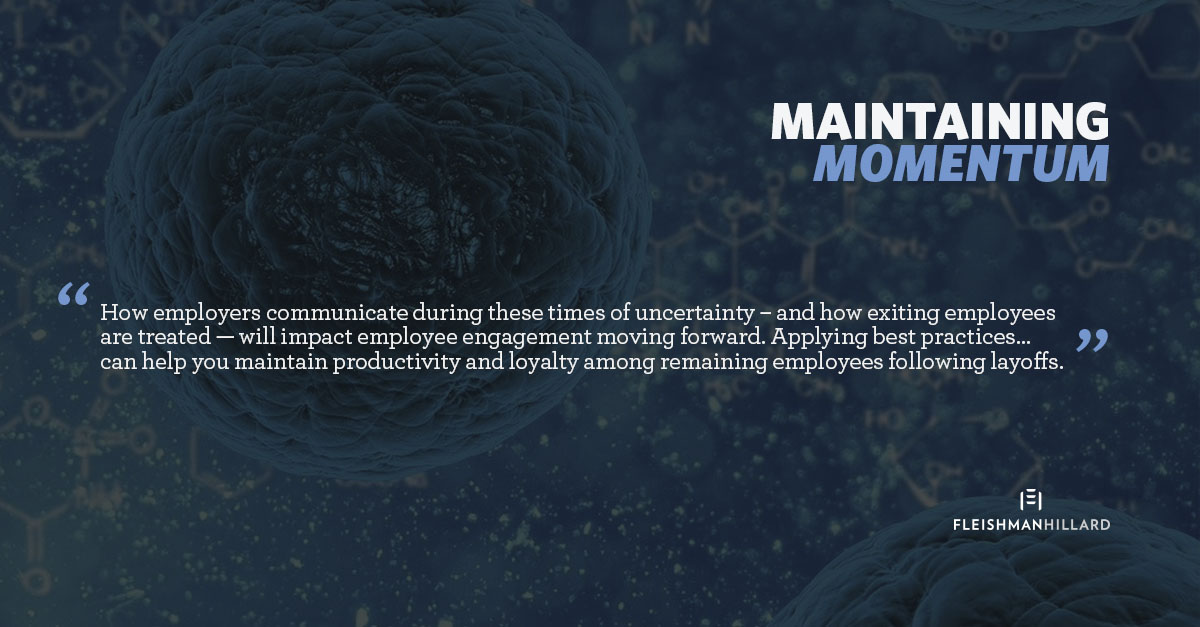Maintaining Momentum After a Reduction in Force
In the constantly evolving COVID-19 environment, only one thing is certain: change. Change for you, your company and your employees. Among the myriad challenges the pandemic has created for employers, reductions in force (RIF) — whether temporary furloughs or permanent layoffs — are one of the most difficult and delicate to navigate.
Though sometimes a necessary tool in a company’s overall cost-reduction strategy, layoffs have potentially serious morale consequences that can cause productivity and quality issues, as well as unwanted talent drain — immediate and longer-term. Handling a RIF during a devasting global issue like COVID-19 significantly raises those stakes. According to recent FleishmanHillard COVID-19 research, 10 percent of employees will no longer be loyal to their employer because of how they behaved during the pandemic.
How employers communicate during these times of uncertainty — and how exiting employees are treated — will impact employee engagement moving forward. Applying best practices from FleishmanHillard’s three decades of RIF experience can help you maintain productivity and loyalty among remaining employees following layoffs.
Engage and align leaders. Employees are looking to their leaders for clarity and guidance. Ensure leaders, mid-level managers and HR specialists are trained, coordinated and prepared to consistently communicate the why behind these difficult, but necessary actions … and the measures in place to help impacted employees with their transitions.
Be compassionate — but clear. Any RIF is difficult for employees, whether temporary or not. With safety restrictions on in-person meetings, RIF notification conversations over video can feel particularly cold. To mitigate this, acknowledge the less-than-ideal circumstances. If individual notifications are possible, one-on-one conversations remain best practice. If a virtual group notification is required due to logistics, make it clear to employees that this is not an approach you would take in normal circumstances. Follow up with individual conversations with all impacted employees. Provide specific, straightforward information regarding the employee’s departure (length of furlough, guidance on qualification for unemployment benefits, severance packages, retirement benefits, career transition support, etc.) and a dignified exit. To those who remain, articulate a clear path forward that continues to build trust and provide hope for their future. If there is a plan for returning furloughed employees to work, clarify the criteria under which that will happen, how you’ll notify them and the timeline, if known.
Protect your employees and your company. Layoffs can be emotionally charged. Provide security that protects employees but does not communicate an “armed camp.” Be sure to protect your intellectual assets as well, safeguarding sensitive company information on employees’ computers or in their files and restricting their access to work-related information. If furloughing employees, be sure to understand and follow all applicable laws, regulations and labor agreements. Typically, employees cannot engage in any work on behalf of the company for any length of time, including taking calls or monitoring email, without receiving payment.
Engage furloughed employees regularly. Typically, employees on furlough can choose to voluntarily receive non-work-related company communications. Consider offering high-level company news updates, resources around wellness or training opportunities (if the training does not provide services to, or generate revenue for, the company) to ensure employees feel connected and supported professionally. To maintain personal relationships, consider hosting virtual happy hours or hobby-based social clubs, such as a virtual book club. Just be sure to avoid any work-related conversation.
Establish alternate channels to reach furloughed employees. While furloughed employees cannot be contacted via company email, collaboration tools or company-provided devices, there are ways to reach them. Personal devices and email accounts (with employee permission), direct mail, dedicated social channels and intranets scrubbed of project-related information can all be used to share recall information, such as changes in time frame and which roles and locations will return first.
Gather — and address — feedback. Informal conversations, focus groups or a dedicated email address for feedback can unearth RIF-related issues that management should address. These pulse checks can help gauge credibility, morale and engagement, and identify questions employees want answered. If your company must permanently downsize, restructure and/or pursue layoffs, review this checklist for a guide to communicating throughout the process. Each step ensures communications teams and stakeholders are aligned and prepared throughout the transition.
Consider the impact on your employer brand. For better or worse, your RIF or furlough approach will be a discussion topic and possible sticking point for potential new hires now and in the future. Fourteen percent of job candidates will look into how a company behaved during the pandemic when considering whether to work there. Your company’s treatment of its employees throughout COVID-19 will become a case study they will examine closely. How you handle a RIF or furlough is another piece of the employee puzzle you need to get right – for the sake of both current and future employees.
View additional COVID-19 counsel from the FleishmanHillard global network here.

